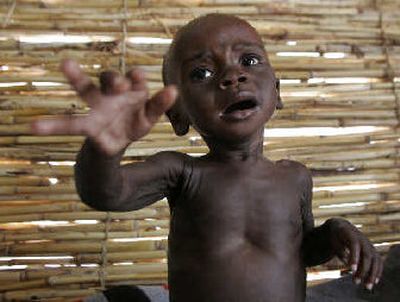Niger’s cycle of hunger

DAKAR, Senegal – In Niger, a desert country twice the size of Texas, most of the 11 million people live on a dollar a day. Forty percent of children are underfed, and one out of four dies before turning 5.
And that’s when things are normal. Throw in a plague of locusts, and a familiar spectacle emerges: skeletal babies, distended bellies, people too famished to brush the flies from their faces.
To the aid workers charged with saving the dying, the immediate challenge is to raise relief money and get supplies to the stricken areas. They leave it to the economists and politicians to come up with a lasting remedy.
One such economist is James Shikwati. He blames foreign aid.
“When aid money keeps coming, all our policy-makers do is strategize on how to get more,” said Shikwati, the Kenya-based director of the Inter Region Economic Network, an African think tank.
“They forget about getting their own people working to solve these very basic problems. In Africa, we look to outsiders to solve our problems, making the victim not take responsibility to change.”
Moving the aid can be nightmare in itself. Africa’s good roads are few, and often pass through the front lines of civil wars. But Shikwati notes an additional problem: Even African countries that have food to spare can’t easily share it because tariffs on agricultural products within sub-Saharan Africa average as high as 33 percent, compared with 12 percent on similar products imported from Europe.
“It doesn’t make sense when they can’t even allow their neighbors to feed them. They have to wait for others in Europe or Asia to help,” he said. “We don’t have any excuses in Africa. We can’t blame nature. We have to tell our leadership to open up and get people producing food.”
Nature, of course, does bear some of the blame. Recurring drought is a part of life in Africa. Farmers have learned to cope, but exploding population growth sucks up water, pasture and livestock.
Many food crises result from bad government and civil wars. For 30 years after winning independence from France, Niger was ruled by coup and military dictatorship. Now it’s a peaceful multiparty democracy, but its desert is getting bigger and drought is unrelenting
All it took was the locust swarms of a year ago, the worst in 15 years, to start tipping Niger over the edge. The crop-devouring insects ravaged an estimated 7,000 square miles of Niger farmland. The combined drought-locust onslaught cut cereal production by 15 percent last year, according to the United Nations.
At first, few noticed.
Places like Niger “were never on anybody’s radar screen. They’re not considered important, geopolitically or resourcewise,” said Cathy Skoula, executive director of U.S.-based Action Against Hunger. “It comes down to a question of priorities. But any human life is important.”
Aid groups say Niger’s catastrophe could have been averted – that early warning systems were in place, and the United Nations and other humanitarian agencies warned of imminent food shortages late last year.
In November, Niger’s government issued an emergency appeal for 78,000 tons of food. Donors, busy with higher-profile crises, barely responded.
The following month came the Indian Ocean tsunami that entirely eclipsed Africa’s misery on the world’s TV screens.
Aid workers say heading off famine needs long-term, steady funding.
“Prevention doesn’t sell that much,” said Stefanie Savariaud, spokeswoman for the U.N. World Food Program in Niger’s capital, Niamey. “The world has to wait for images of dying children to react. The question is, how to mobilize the international community when it’s still preventable?”
Ironically, only three weeks ago the world’s attention was fixed on Africa again, when the G-8 summit pledged to double African aid to $50 billion and granted 18 of its countries, including Niger, debt forgiveness. At the same time, rock concerts televised worldwide made sure Africa’s troubles stayed high on the global agenda.
A week later, TV pictures of hungry people began beaming out of Niger, and donors reached for their wallets.
But the World Food Program has raised only $9 million of the $16 million it appealed for, Savariaud said.
At a feeding center in Mada Roufa, in eastern Niger, Mai Sali, a local employee of the international relief organization Doctors Without Borders, praised those efforts, but agreed crisis aid was not the answer.
“We need to find other long-term solutions,” he said. “We can’t just address emergencies.”